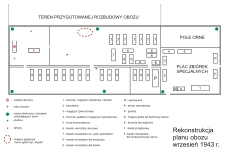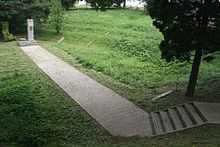Szebnie concentration camp
| Szebnie concentration camp | |
|---|---|
| Concentration camp | |
 Camp plan, September 1943 | |
 Location of Szebnie in modern Poland
| |
| Coordinates | 49°46′N 21°36′E / 49.767°N 21.600°ECoordinates: 49°46′N 21°36′E / 49.767°N 21.600°E |
| Location | Szebnie, occupied Poland |
| Operated by | Schutzstaffel (SS) |
| Original use | Civilian internment camp |
| Operational | June 1941 – August 1944 |
| Inmates | Jews, Poles, Ukrainians, Roma |
| Killed | 10,000 |
| Liberated by | The Red Army |
| Website | Szebnie at Virtual Shtetl |
The Szebnie concentration camp (German: Lager Szebnie)[2] was established during World War II by Germany, within the semi-colonial territory of General Government in the south-eastern part of occupied Poland. It was located near the town of Szebnie approximately 10 kilometres (6 mi) east of Jasło and 42 km (26 mi) south-west of Rzeszów.[3] The facility was constructed in 1940 originally as horse stables for the Wehrmacht, adjacent to a manorial estate where the German officers stationed (photo). Over the course of the camp's operation thousands of people perished there, including Soviet prisoners of war, Polish Jews, non-Jewish Poles, Ukrainians, and Romani people. The charred remains of the camp were entered by the Soviets on 8 September 1944.[4]
Camp operation
The camp covered an area of about 10 hectares with some 35 barracks eventually. First, it became a POW camp (Kriegsgefangenenlager) in late June 1941 for some 6,000 Red Army soldiers,[4] captured in the Soviet zone of occupied Poland after the implementation of Operation Barbarossa. The POWs built the first 20 barracks with three-level bunk-beds (not enough for all).[4] Most of them perished from disease and hunger with no heat in winter, and no laundry or bath; up to 200 a day.[4] The only person who helped the sick during typhus epidemic was a courageous young lady, Helena Gorayska, who paid for it with her own life in 1942 infected with typhus.[1] Some other locals also offered foodstuffs.[4]
In the spring of 1943 the camp was reinstated as concentration camp (Arbeitslager und Konzentrationslager),[5] for Poles, Jews, Ukrainians, and Gypsies.[4] The first new prisoners arrived in Holocaust trains from the Jewish ghettos liquidated across occupied Poland. By August, it held 1,040 people.[6] By the fall of 1943 the number of prisoners reached 5,000 including Jews and non-Jews from Rzeszów,[7] Tarnów, Bochnia,[8] Jasło, Frysztak, Dukla and Pustków.[6] The Jews had been appointed the camp's only Kapos compelled to maintain discipline and administer torture.[8] Eventually, the camp held about 10,000 deportees,[9] men, women, and children. Some prisoners were employed at a tailor shop for the German military, but most worked at various earth works in the area; at the gravel pit, in the SS farm, at the oil refinery in Niegłowice, and at the Hitler's Bunker in Stępina. The camp was surrounded by barb-wire fences with six guard towers and search lights around the perimeter.[9]
The camp commandants included Untersturmführer Anton Scheidt (inventor of prisoner "crew train" running 12-hour shifts round-the-clock),[10] Hauptsturmführer Hans Kellermann (connoisseur of young camp-women, put in jail by the SS for stealing from the Reich), and SS-Hauptsturmführer Karl Blank (as the last, for just two weeks).[4][11] Notably, stealing collected gold and money to be rich, was a common practice among concentration camp commandants; two of them, Koch and Florstedt both from Majdanek, were executed by the SS for the same reason in April 1945.[12] Through the whole existence of the camp the commandants resided in the Gorayski manor, holding wild drinking parties for the SS several times a week (Scheidt) and trapping scores of attractive Jewish and non-Jewish "house maids" (Kellermann).[11]
Camp liquidation
In August 1943, the Jews were separated from the rest of prisoners in a special Jewish zone on the north side of the camp behind a barb-wire fence (see map).[4] Subsequently, almost two thousand were murdered in mass executions at the Dobrucowa Forest nearby in the fall and winter of 1943,[4] on the orders of SS-Hauptsturmführer Amon Goeth from Płaszów.[13] Some 700 Jews were killed in one day on 22 September 1943, forced to undress. Their bodies were incinerated on site by the end of the month. On 6 October, another group of 500 Jews were shot and burned.[8] On 5 November 1943, some 2,800 Jews were loaded onto Holocaust trains to meet their death in the Auschwitz concentration camp. Seven are known to have escaped.[8] By February 1944 only 80 Jews remained in the camp. They were transported to Kraków-Płaszów. Most of the remaining non-Jewish prisoners were evacuated in 14–25 August 1944 further west to Grybów camp, except for some 300 of the weakest.[4]

The camp was used temporarily for four months (between February and July 1944), to keep additional Soviet POWs. It was known as Stalag 325 even though in 1942 it was known as Stalag 327, apparently not perceived as sequential by German administration.[14][15] The POWs were massacred by the Ukrainian 14th Waffen SS Division soldiers,[16] brought in specifically for this purpose from the SS Heidelager troop-training facility in Pustków nearby.[17][18] Most of the barracks were burned down. The remains of the camp were entered by the Soviet Red Army on 8 September 1944.[4] The site has not been protected legally. Usable building materials were eventually hauled away.[4]
References
- ↑ 1.0 1.1 CATL (27 June 2012). "Helena Gorayska i St. Dubiel na tle dworku w Szebniach – 1938r" (in Polish). Gminna Biblioteka Publiczna w Jaśle; Cyfrowe Archiwum Tradycji Lokalnej. Retrieved 4 July 2013.
- ↑ Ulrich Herbert, Karin Orth (Jan 1, 1998). Die nationalsozialistischen Konzentrationslager: Entwicklung und Struktur (in German). Wallstein Verlag. p. 420. ISBN 3892442894. Retrieved 8 July 2013.
- ↑ "Central Statistical Office (GUS) – TERYT (National Register of Territorial Land Apportionment Journal)" (in Polish). 1 June 2008.
- ↑ 4.0 4.1 4.2 4.3 4.4 4.5 4.6 4.7 4.8 4.9 4.10 4.11 Jacek Bracik, Józef Twaróg (2003). "Obóz w Szebniach (Camp in Szebnie)" (Internet Archive) (in Polish). Region Jasielski, nr 3 (39). Retrieved 4 July 2013.
- ↑ ITS (2013). "2,500 Companies – Slave Labour in the Nazi Camp System" (PDF file, direct download 1.03 MB). Liste der Unternehmen, die im Nationalsozialismus von der Zwangsarbeit profitiert haben (in German with English preface). Zweitausendeins.de. pp. 89, 213 (246). Retrieved 4 July 2013.
- ↑ 6.0 6.1 Tarnów Museum (2013). "Prison and work camp in Szebnie". Memories Saved From Fire - Project of Regional Museum in Tarnów. Tarnów State Museum. Retrieved 9 July 2013.
- ↑ Stefan Krakowski (2013). "Rzeszow. Holocaust Period". Encyclopaedia Judaica. Jewish Virtual Library. Retrieved 8 July 2013. "In September 1943 able-bodied Jews of Rzeszów were transported to Szebnia, where the majority met their death."
- ↑ 8.0 8.1 8.2 8.3 V.S. (2013). "Szebnie – obóz pracy przymusowej i miejsce egzekucji". Places of martyrology (in Polish). Museum of the History of Polish Jews (Muzeum Historii Żydów Polskich) Virtual Shtetl. Retrieved 4 July 2013. "Funkcje obozowe przeznaczone dla więźniów powierzano tylko Żydom, którzy tym samym nadzorowali Polaków i Cyganów. Nadzorcy z wyjątkowym okrucieństwem znęcali się nad współwięźniami."
- ↑ 9.0 9.1 Ronald Berger (12 July 2010). "Surviving the Concentration Camps" (Google Book). Surviving the Holocaust: A Life Course Perspective. Taylor & Francis. pp. 91–92. ISBN 0203848519. Retrieved 4 July 2013.
- ↑ David Crowe (1 August 2007). "SS-Untersturmführer Anton Scheidt (mention)" (Google Book preview). Oskar Schindler: The Untold Account of His Life, Wartime Activities, and the True Story Behind the List. Basic Books. p. 354. ISBN 0465008496. Retrieved 6 July 2013.
- ↑ 11.0 11.1 Karolina Ożóg (12 April 2011). "Szebnie". Der SS und Polizeifuhrer in Distrikt Krakau Zwangsarbeitslager Szebnie (in Polish). Muzeum Historii Żydów Polskich Virtual Shtetl. p. 2 of 7. Retrieved 6 July 2013.
- ↑ "Procesy zbrodniarzy (Trials of war criminals) 1946–1948". Wykaz sądzonych członków załogi KL Lublin/Majdanek. KL Lublin. Retrieved 7 July 2013.
- ↑ United Nations War Crimes Commission (1 September 1997). Law Reports of Trials of War Criminals. Wm. S. Hein Publishing. pp. 1–10 (Case no. 37). Retrieved 6 July 2013.
- ↑ "Stalag 327, Poland". Stalag: Camp, Location, Country. German Stalag Camps. Retrieved 5 July 2013.
- ↑ "Szebnie bei Sanok : Stalag 325 (2–7.1944) / Stalag 327 (3–11.1942)" (Internet Archive). POW Camp Listings. The National Ex-Prisoner of War Association. 2008. Retrieved 6 July 2013.
- ↑ Terry Goldsworthy (2010). "Valhalla's Warriors" (Google Book preview). A History of the Waffen-SS on the Eastern Front 1941–1945. Dog Ear Publishing. p. 144. ISBN 1608446395. Retrieved 5 July 2013.
- ↑ "HL-Heidelager: SS-TruppenÜbungsPlatz" (with collection of historical photographs). Historia poligonu Heidelager w Pustkowie (in Polish). Pustkow.Republika.pl. 2013. Retrieved 6 July 2013.
- ↑ Howard Margolian (2000). Unauthorized entry: the truth about Nazi war criminals in Canada, 1946–1956. University of Toronto Press. p. 132. ISBN 0802042775. Retrieved 6 July 2013.
| |||||||||||||||||||||||||||||||||||||||||||||||||||||||||||||||||||||||||||||||||||||||||||||||||||||||||||||||||||||||||||||||||||||||||
